Arc Security
Real Estate Agent Safety Reimagined
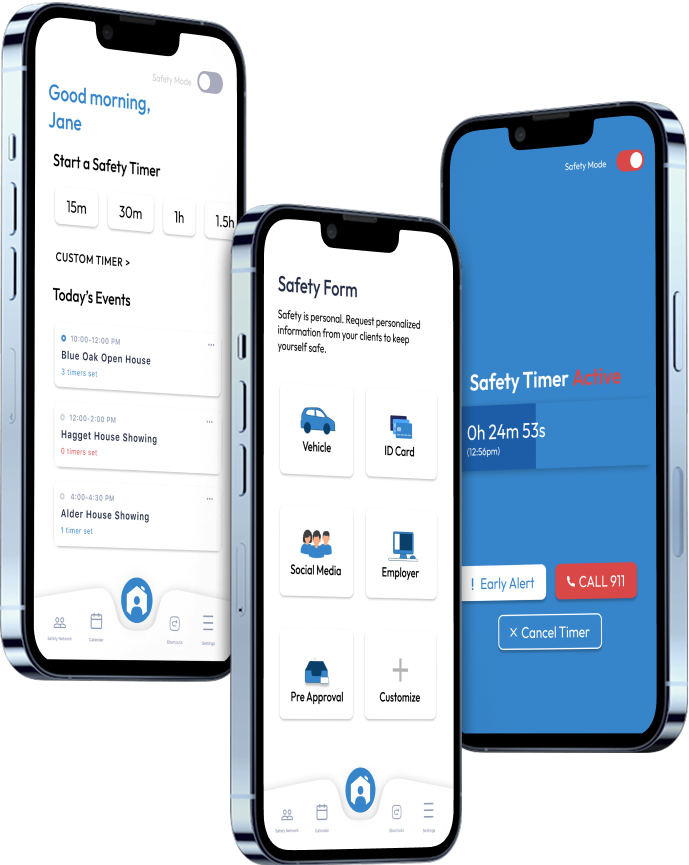
Role
Lead UX Designer
Intern
Timeline
Sept – Dec 2022 (3 months)
Team
4 design interns
5 dev interns
Tools
Figma
Illustrator
Problem
Personalized and discreet integration into the user’s pre-existing workflow, prioritizing ease and quick access in high-pressure situations.
According to the National Association of Realtors, 33% of agents have experienced a situation that made them fear for their safety. They spend hours with strangers at showings or open houses, often in isolated locations. Yet, there is no industry-wide solution for employee safety management.
“At the end of the day after many long hours of showing homes, I pour myself a glass of wine, sit down on the couch, and think about all the moments that things could have gone wrong.”
- Anonymous Licensed Real Estate Agent from our interviews
Solution
Personalized and discreet integration into the user’s pre-existing workflow, prioritizing ease and quick access in high-pressure situations.
Safety Form
- Implementing agent’s survey answers as add-on options to create an intuitive experience
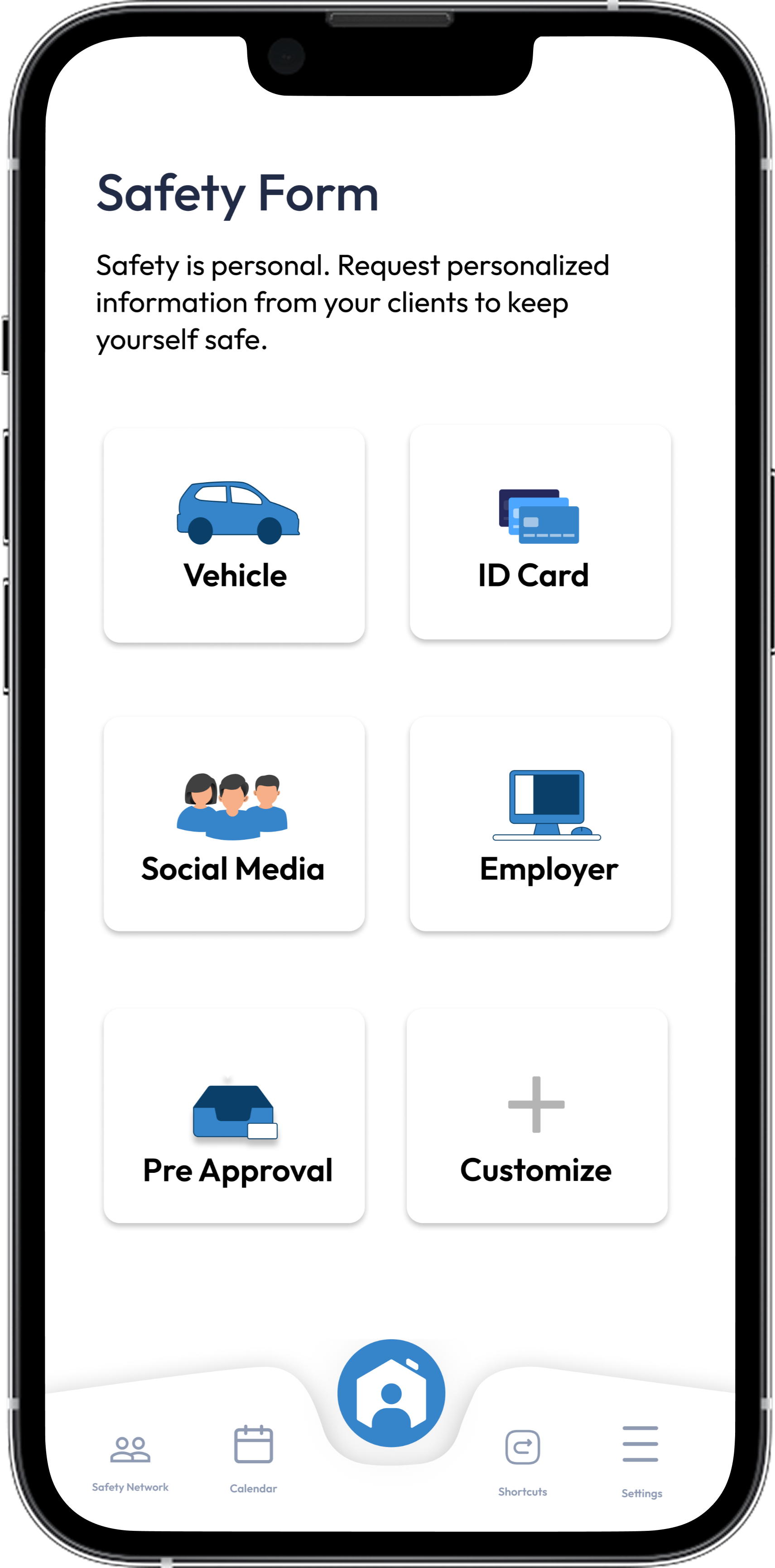
Shortcuts
- Using pre-existing shortcut features for quick integration into an agent’s phone.
- The use of Arc in an emergency setting is discreet
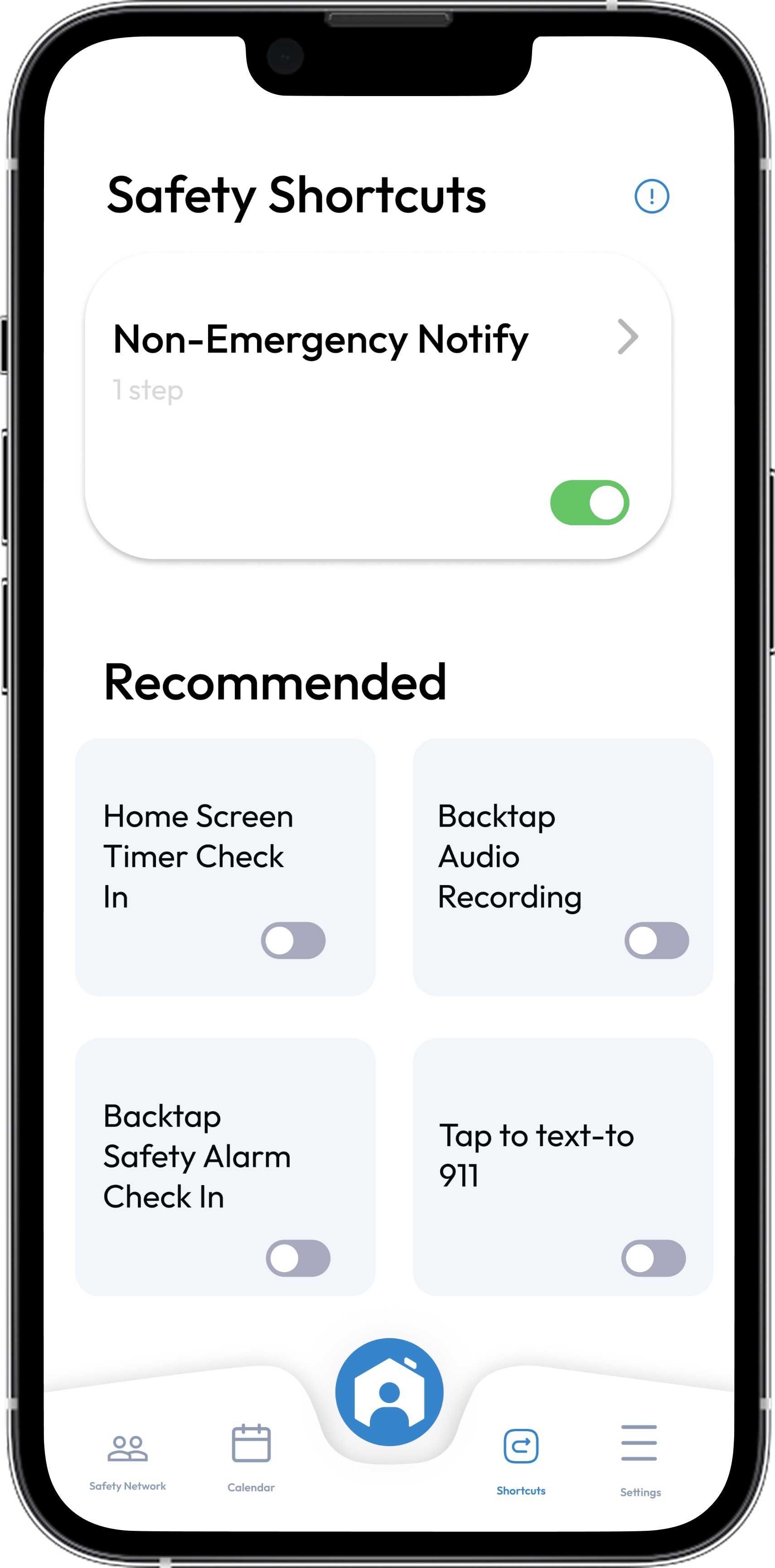
Safety Mode
- Allow users to focus on doing their job in a house showing while still ready for anything
- Text-to-911 feature option with “Early Alert” sends emergency services and emergency contacts information on where and who the agent is with
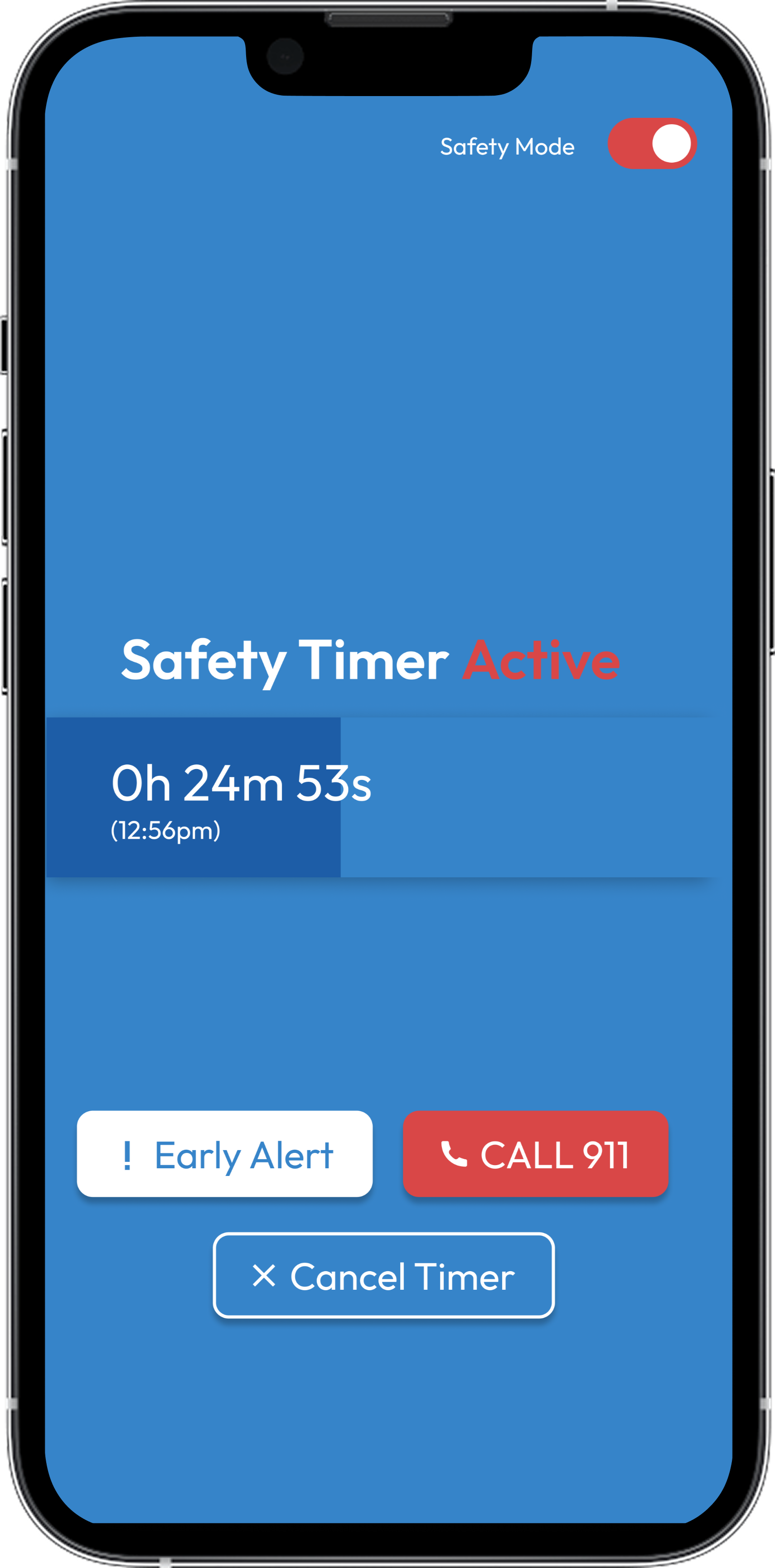
Home Screen Efficiency
- Home screen has events for the day option to create a timer
- “Start a safety timer” in impromptu moments of need outside of scheduled times
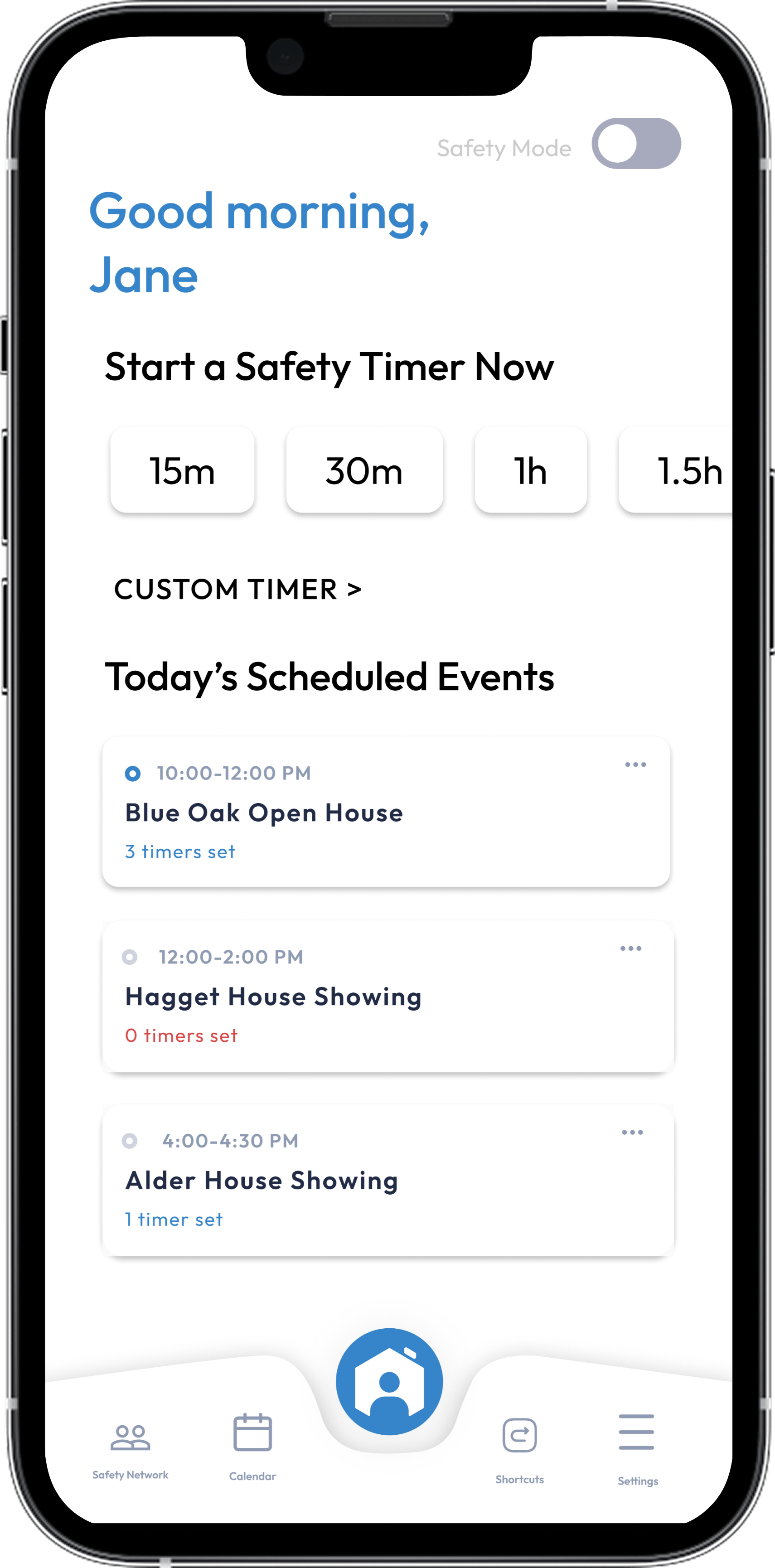
Research
Safety solutions should offer automation, discretion, and personalized check-ins to support accurate real-world usability.
To understand agents’ needs, I conducted a multi-faceted research approach that included surveys, interviews, and competitive analysis:
- Survey: 237 surveys total to agents in Arc’s database for insights on current safety practices, concerns, and preferences on features
- Interviews: exploring emotional and situational safety concerns that weren’t fully captured in survey responses - how do statistics contribute to individual struggles?
- Competitive analysis: evaluated existing safety solutions (Life360, Guardian, internal brokerage measures) to identify gaps where our design could provide value
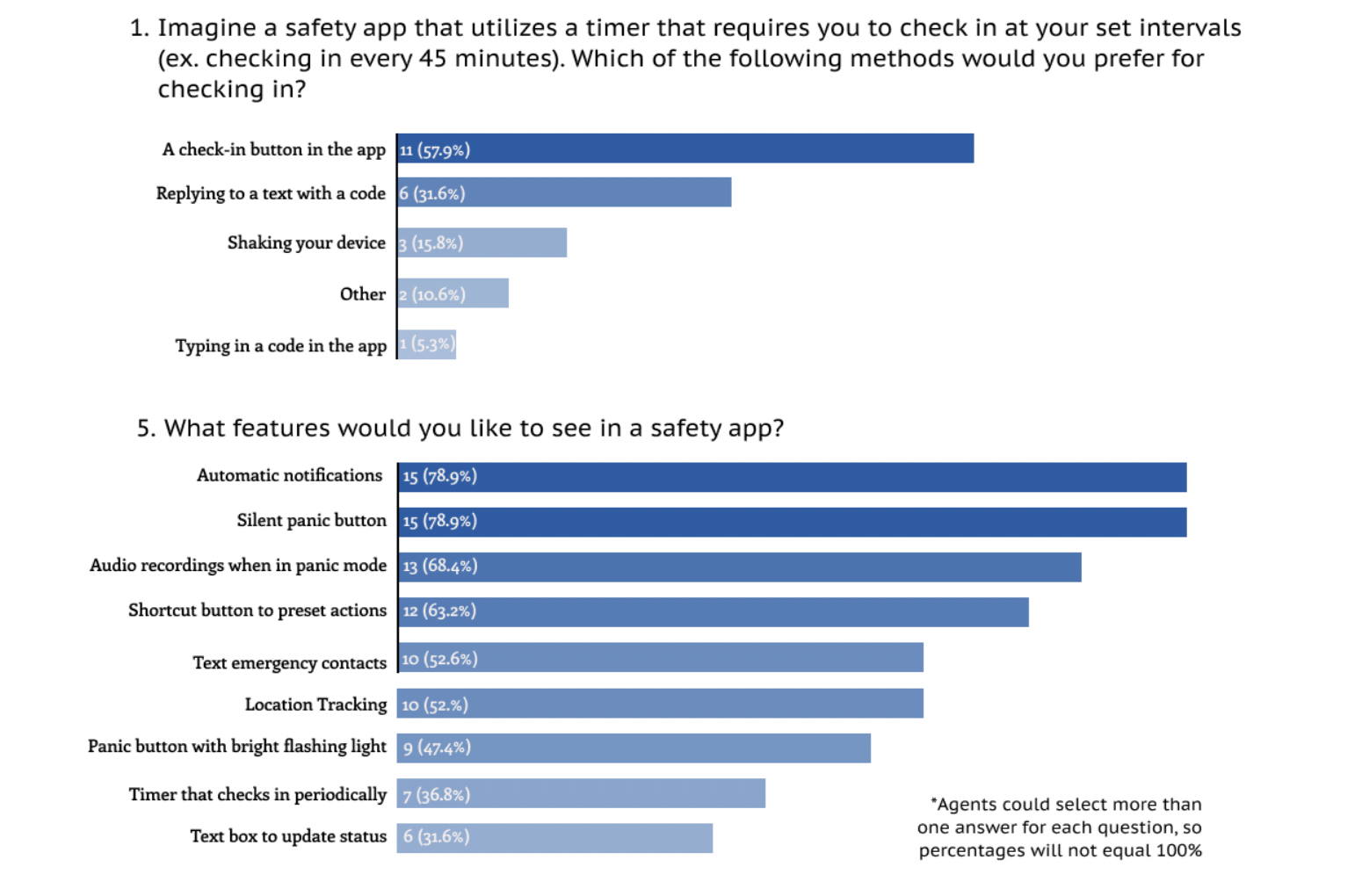
From the research, I identified the following takeaways to shape our design approach:
1
Seamless integration
Agents already use informal safety procedures (ex. sharing location), so a new solution must compliment existing habits rather than replace them
2
Automation over manual check-ins
Many agents prefer automated safety features, as they often forget to manually update colleagues or family during a showing
3
Discreet emergency activation
Alerts must be low-profile with silent activation options to avoid drawing attention in high-risk situations
4
Personalized safety settings
Risk tolerance varies, so the system needs customizable check-ins and alerts
Ideation
Integrating user insights to improve the home page to prioritize high-stress usability.
Home Page: Agents needed quick access to critical information without feeling overwhelmed, especially in high-stress situations. I iterated on homepage layouts, having the home bar highlight essential functions while keeping frequent actions displayed within immediate reach, like the day’s events and starting an impromptu timer outside of a scheduled one.
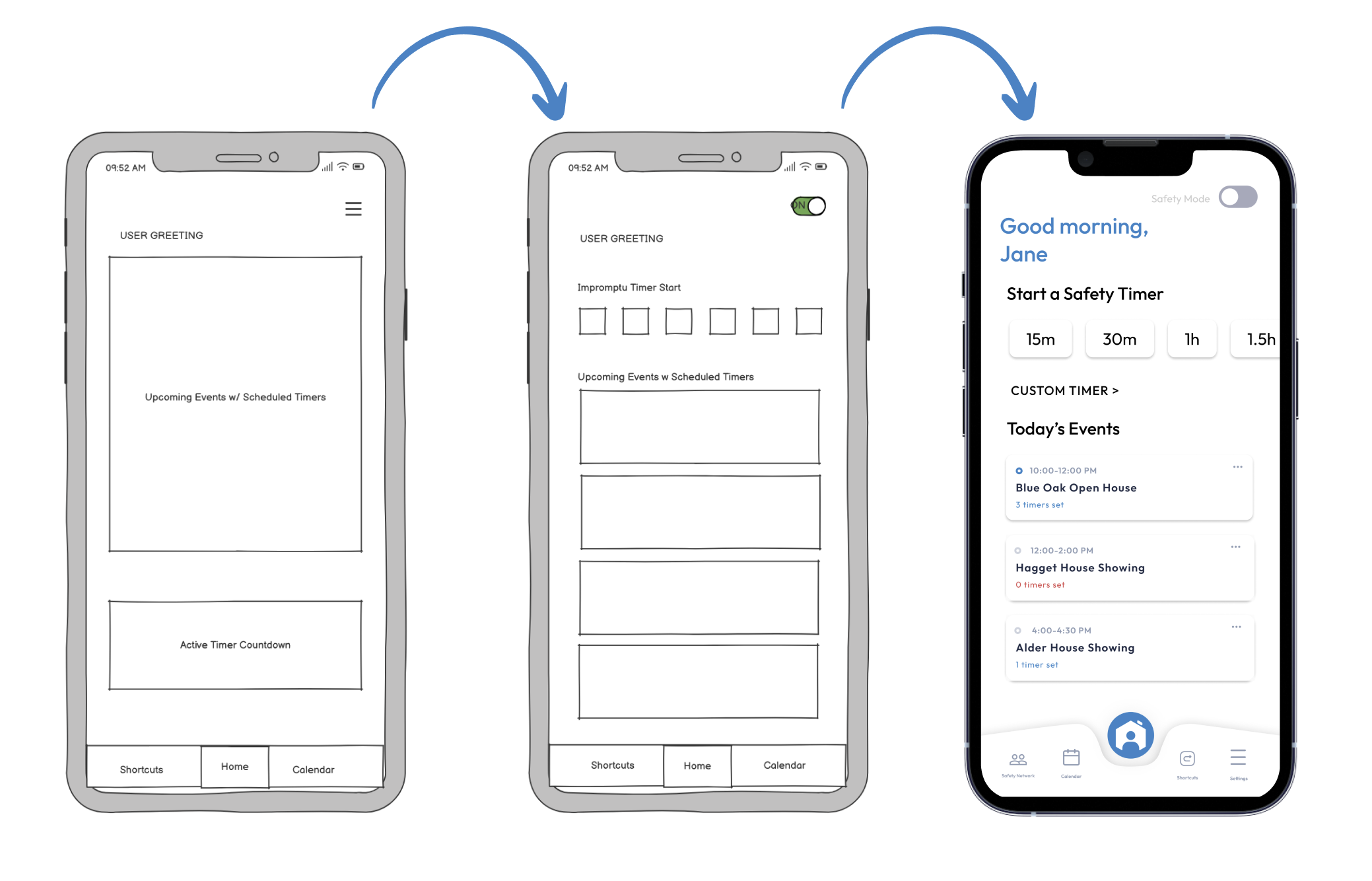
Shortcuts, Safety Form, Countdown: Agents have to handle a lot of information, including client information as well as showing information, so we knew that adding their personal safety information/decisions required simple layouts that would reduce cognitive load. We prioritized that thinking when wireframing these three critical pages, including the creation of the safety timer to remove it from the home page (as seen in the second home page iteration).
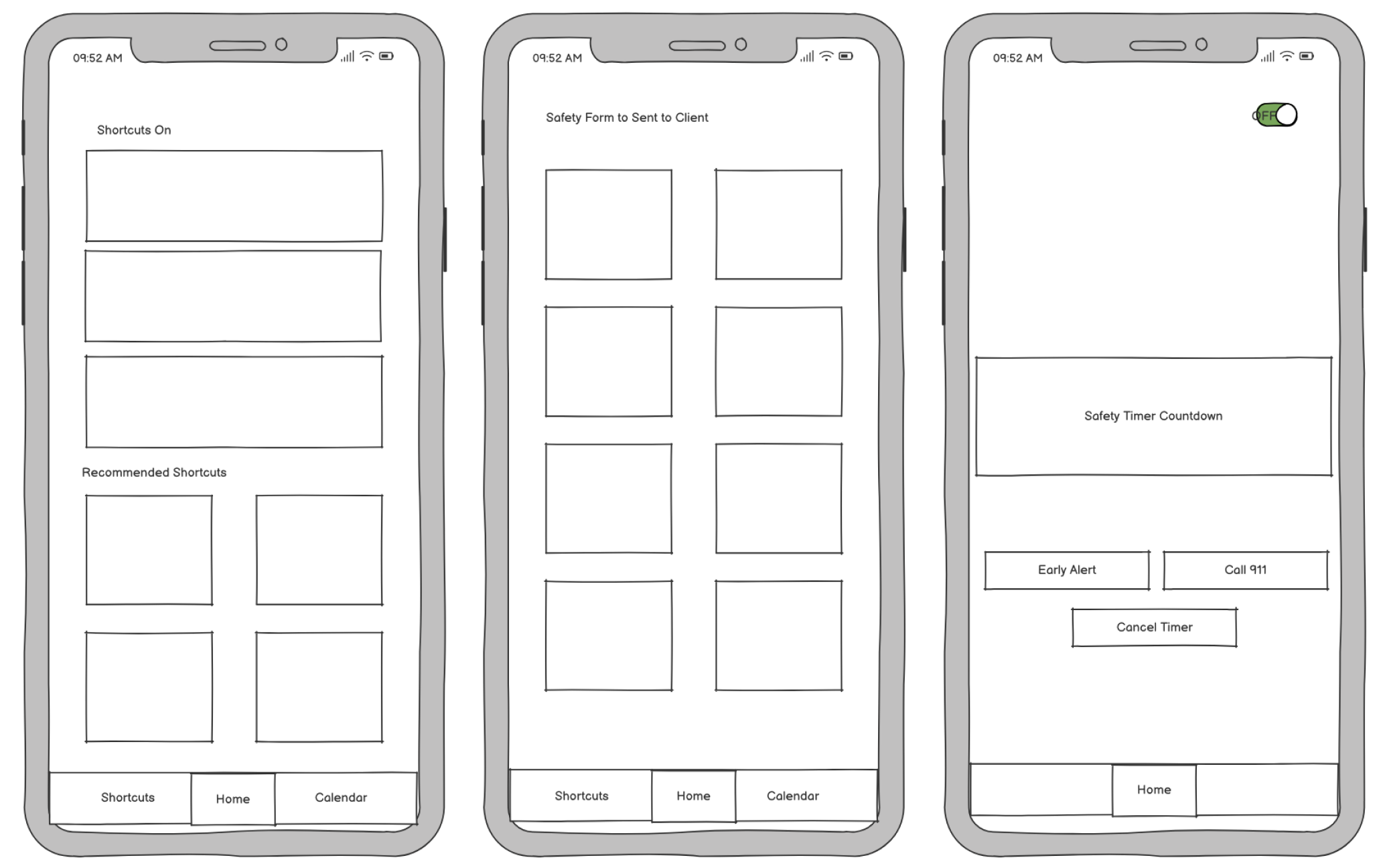
I created the following information architecture for the app’s navigation and features:
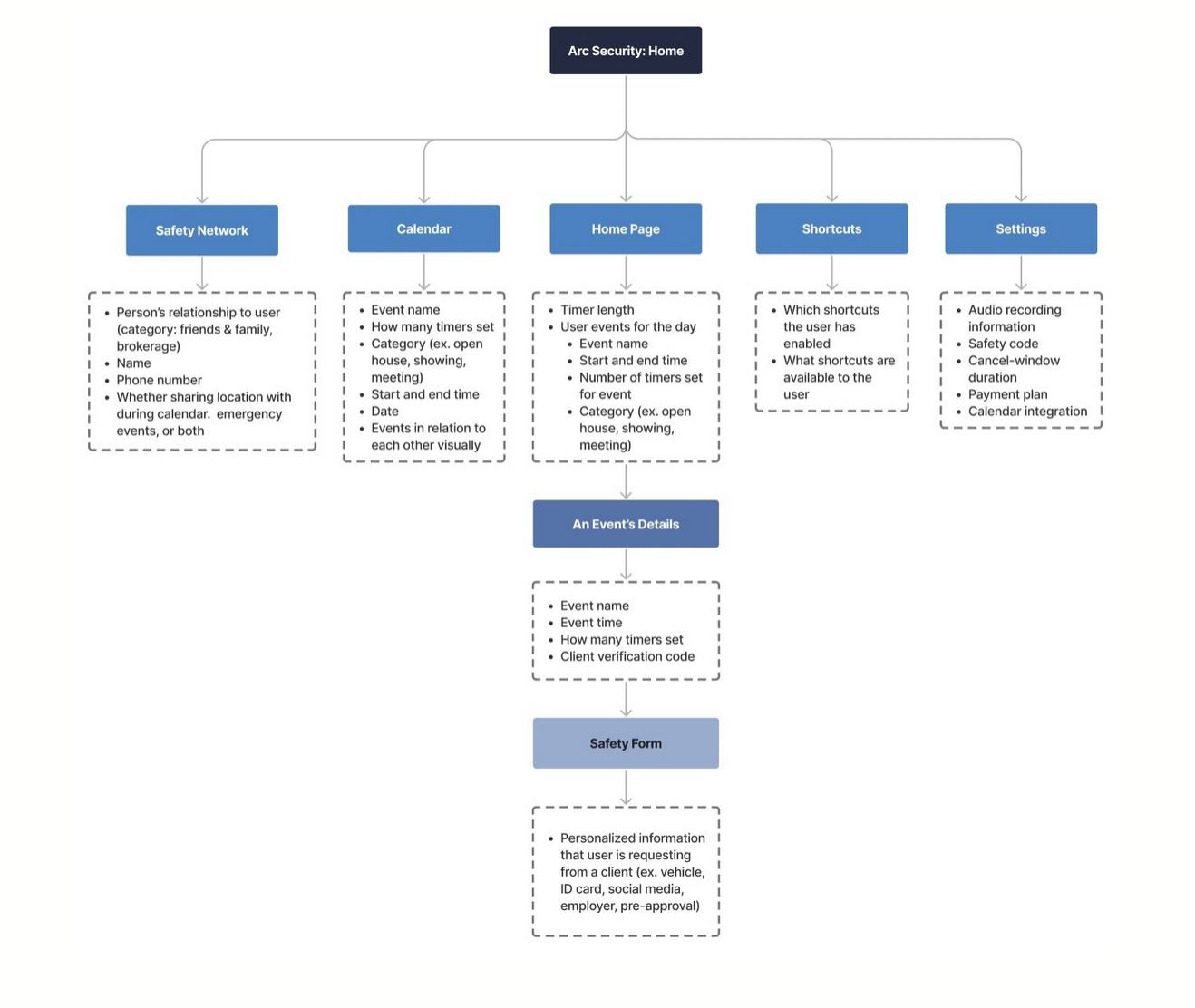
Style Guide
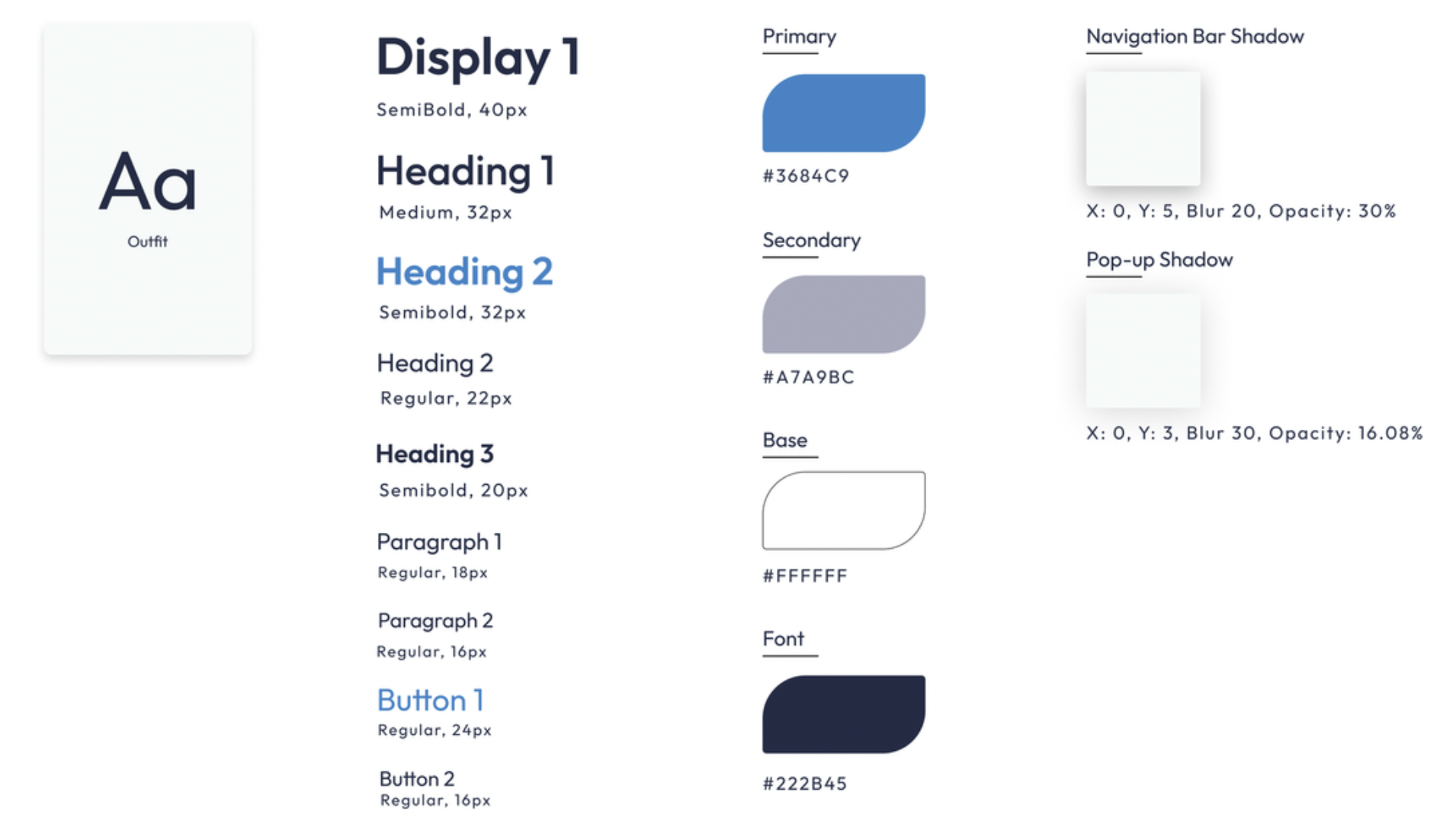
Final Solution
Reflection
Collaboration, leadership, and more lessons from a cross-functional project.
This was my first internship and full-scale collaborative project! I'm deeply grateful to the Arc team for trusting us to bring their idea to life. Working on a cross-collaborative project with real potential to improve users' lives, both physically and mentally, was incredibly rewarding. I'm excited to apply these lessons to future projects! I learned so much about both design processes and real-world collaboration. My biggest lessons included:
- Leading design sprints: This project built my confidence in structuring workshops, ensuring every team member had a voice while keeping us focused and productive.
- Navigating team dynamics: I learned to balance fairness and kindness, ensuring constructive feedback, even responsibility distribution, and open communication.
- Collaborating with developers: This was my first time working with a development team. I was initially surprised by the natural checks and balances that emerged, but quickly realized this strengthened our product. The lead developer and I made it a priority to reinforce that we weren't separate teams, but one unified team. I've started learning front- and back-end development to communicate more effectively with engineering teams and ensure my designs are both innovative and feasible.
While I'm proud of what we accomplished, I'd approach a few things differently:
- More frequent user testing: Time constraints limited us to testing with few users. While we gained valuable insights, broader testing would have better validated our design decisions. I'd push for earlier, more consistent testing cycles.
- Stronger early alignment: Though our design-development communication improved over time, I'd establish a stronger workflow from the beginning, ensuring feasibility discussions happen alongside design ideation.
Arc Security
Real Estate Agent Safety Reimagined

Role
Lead UX Designer Intern
Timeline
Sept – Dec 2022
(3 months)
Team
4 design interns
5 dev interns
Tools
Figma
Illustrator
Problem
Personalized and discreet integration into the user’s pre-existing workflow, prioritizing ease and quick access in high-pressure situations.
According to the National Association of Realtors, 33% of agents have experienced a situation that made them fear for their safety. They spend hours with strangers at showings or open houses, often in isolated locations. Yet, there is no industry-wide solution for employee safety management.
“At the end of the day after many long hours of showing homes, I pour myself a glass of wine, sit down on the couch, and think about all the moments that things could have gone wrong.”
- Anonymous Licensed Real Estate Agent from our interviews
Solution
Personalized and discreet integration into the user’s pre-existing workflow, prioritizing ease and quick access in high-pressure situations.
Safety Form
- Implementing agent’s survey answers as add-on options to create an intuitive experience

Shortcuts
- Using pre-existing shortcut features for quick integration into an agent’s phone.
- The use of Arc in an emergency setting is discreet

Safety Mode
- Allow users to focus on doing their job in a house showing while still ready for anything
- Text-to-911 feature option with “Early Alert” sends emergency services and emergency contacts information on where and who the agent is with

Home Screen Efficiency
- Home screen has events for the day option to create a timer
- “Start a safety timer” in impromptu moments of need outside of scheduled times

Research
Safety solutions should offer automation, discretion, and personalized check-ins to support accurate real-world usability.
To understand agents’ needs, I conducted a multi-faceted research approach that included surveys, interviews, and competitive analysis:
- Survey: 237 surveys total to agents in Arc’s database for insights on current safety practices, concerns, and preferences on features
- Interviews: exploring emotional and situational safety concerns that weren’t fully captured in survey responses - how do statistics contribute to individual struggles?
- Competitive analysis: evaluated existing safety solutions (Life360, Guardian, internal brokerage measures) to identify gaps where our design could provide value

From the research, I identified the following takeaways to shape our design approach:
1
Seamless integration
Agents already use informal safety procedures (ex. sharing location), so a new solution must compliment existing habits rather than replace them
2
Automation over manual check-ins
Many agents prefer automated safety features, as they often forget to manually update colleagues or family during a showing
3
Discreet emergency activation
Alerts must be low-profile with silent activation options to avoid drawing attention in high-risk situations
4
Personalized safety settings
Risk tolerance varies, so the system needs customizable check-ins and alerts
Ideation
Integrating user insights to improve the home page to prioritize high-stress usability.
Home Page: Agents needed quick access to critical information without feeling overwhelmed, especially in high-stress situations. I iterated on homepage layouts, having the home bar highlight essential functions while keeping frequent actions displayed within immediate reach, like the day’s events and starting an impromptu timer outside of a scheduled one.

Shortcuts, Safety Form, Countdown: Agents have to handle a lot of information, including client information as well as showing information, so we knew that adding their personal safety information/decisions required simple layouts that would reduce cognitive load. We prioritized that thinking when wireframing these three critical pages, including the creation of the safety timer to remove it from the home page (as seen in the second home page iteration).

I created the following information architecture for the app’s navigation and features:

Style Guide

Final Solution
Reflection
Collaboration, leadership, and more lessons from a cross-functional project.
This was my first internship and full-scale collaborative project! I'm deeply grateful to the Arc team for trusting us to bring their idea to life. Working on a cross-collaborative project with real potential to improve users' lives, both physically and mentally, was incredibly rewarding. I'm excited to apply these lessons to future projects! I learned so much about both design processes and real-world collaboration. My biggest lessons included:
- Leading design sprints: This project built my confidence in structuring workshops, ensuring every team member had a voice while keeping us focused and productive.
- Navigating team dynamics: I learned to balance fairness and kindness, ensuring constructive feedback, even responsibility distribution, and open communication.
- Collaborating with developers: This was my first time working with a development team. I was initially surprised by the natural checks and balances that emerged, but quickly realized this strengthened our product. The lead developer and I made it a priority to reinforce that we weren't separate teams, but one unified team. I've started learning front- and back-end development to communicate more effectively with engineering teams and ensure my designs are both innovative and feasible.
While I'm proud of what we accomplished, I'd approach a few things differently:
- More frequent user testing: Time constraints limited us to testing with few users. While we gained valuable insights, broader testing would have better validated our design decisions. I'd push for earlier, more consistent testing cycles.
- Stronger early alignment: Though our design-development communication improved over time, I'd establish a stronger workflow from the beginning, ensuring feasibility discussions happen alongside design ideation.
Arc Security
Real Estate Agent Safety Reimagined

Role
Lead UX Designer Intern
Timeline
Sept – Dec 2022
(3 months)
Team
4 design interns
5 dev interns
Tools
Figma
Illustrator
Problem
Personalized and discreet integration into the user’s pre-existing workflow, prioritizing ease and quick access in high-pressure situations.
According to the National Association of Realtors, 33% of agents have experienced a situation that made them fear for their safety. They spend hours with strangers at showings or open houses, often in isolated locations. Yet, there is no industry-wide solution for employee safety management.
“At the end of the day after many long hours of showing homes, I pour myself a glass of wine, sit down on the couch, and think about all the moments that things could have gone wrong.”
- Anonymous Licensed Real Estate Agent from our interviews
Solution
Personalized and discreet integration into the user’s pre-existing workflow, prioritizing ease and quick access in high-pressure situations.

Safety Form
- Implementing agent’s survey answers as add-on options to create an intuitive experience
Shortcuts
- Using pre-existing shortcut features for quick integration into an agent’s phone.
- The use of Arc in an emergency setting is discreet


Safety Mode
- Allow users to focus on doing their job in a house showing while still ready for anything
- Text-to-911 feature option with “Early Alert” sends emergency services and emergency contacts information on where and who the agent is with
Home Screen Efficiency
- Home screen has events for the day option to create a timer
- “Start a safety timer” in impromptu moments of need outside of scheduled times

Research
Safety solutions should offer automation, discretion, and personalized check-ins to support accurate real-world usability.
To understand agents’ needs, I conducted a multi-faceted research approach that included surveys, interviews, and competitive analysis:
- Survey: 237 surveys total to agents in Arc’s database for insights on current safety practices, concerns, and preferences on features
- Interviews: exploring emotional and situational safety concerns that weren’t fully captured in survey responses - how do statistics contribute to individual struggles?
- Competitive analysis: evaluated existing safety solutions (Life360, Guardian, internal brokerage measures) to identify gaps where our design could provide value

From the research, I identified the following takeaways to shape our design approach:
1
Seamless integration
Agents already use informal safety procedures (ex. sharing location), so a new solution must compliment existing habits rather than replace them
2
Automation over manual check-ins
Many agents prefer automated safety features, as they often forget to manually update colleagues or family during a showing
3
Discreet emergency activation
Alerts must be low-profile with silent activation options to avoid drawing attention in high-risk situations
4
Personalized safety settings
Risk tolerance varies, so the system needs customizable check-ins and alerts
Ideation
Integrating user insights to improve the home page to prioritize high-stress usability.
Home Page: Agents needed quick access to critical information without feeling overwhelmed, especially in high-stress situations. I iterated on homepage layouts, having the home bar highlight essential functions while keeping frequent actions displayed within immediate reach, like the day’s events and starting an impromptu timer outside of a scheduled one.

Shortcuts, Safety Form, Countdown: Agents have to handle a lot of information, including client information as well as showing information, so we knew that adding their personal safety information/decisions required simple layouts that would reduce cognitive load. We prioritized that thinking when wireframing these three critical pages, including the creation of the safety timer to remove it from the home page (as seen in the second home page iteration).

I created the following information architecture for the app’s navigation and features:

Style Guide

Final Solution
Reflection
Collaboration, leadership, and more lessons from a cross-functional project.
This was my first internship and full-scale collaborative project! I'm deeply grateful to the Arc team for trusting us to bring their idea to life. Working on a cross-collaborative project with real potential to improve users' lives, both physically and mentally, was incredibly rewarding. I'm excited to apply these lessons to future projects! I learned so much about both design processes and real-world collaboration. My biggest lessons included:
- Leading design sprints: This project built my confidence in structuring workshops, ensuring every team member had a voice while keeping us focused and productive.
- Navigating team dynamics: I learned to balance fairness and kindness, ensuring constructive feedback, even responsibility distribution, and open communication.
- Collaborating with developers: This was my first time working with a development team. I was initially surprised by the natural checks and balances that emerged, but quickly realized this strengthened our product. The lead developer and I made it a priority to reinforce that we weren't separate teams, but one unified team. I've started learning front- and back-end development to communicate more effectively with engineering teams and ensure my designs are both innovative and feasible.
While I'm proud of what we accomplished, I'd approach a few things differently:
- More frequent user testing: Time constraints limited us to testing with few users. While we gained valuable insights, broader testing would have better validated our design decisions. I'd push for earlier, more consistent testing cycles.
- Stronger early alignment: Though our design-development communication improved over time, I'd establish a stronger workflow from the beginning, ensuring feasibility discussions happen alongside design ideation.